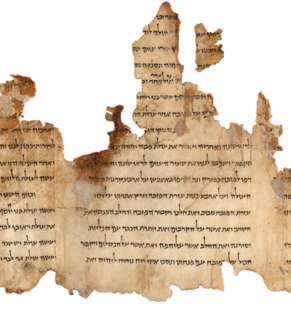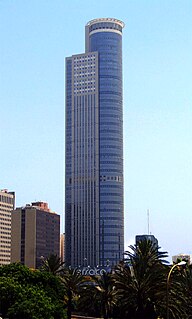
Moshe Safdie, CC, FAIA is an Israeli-Canadian architect, urban designer, educator, theorist, and author. He is most identified with Habitat 67, which paved the way for his international career.
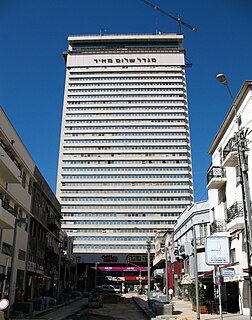
Shalom Meir Tower is an office tower in Tel Aviv, Israel. It was Israel's first skyscraper, and was designed by architects Yitzhak Pearlstein, Gideon Ziv, and Meir Levy. When its construction was completed in 1965, it was the tallest building in the Middle East and rivaled the tallest buildings in Europe in height. To build the tower, the historic Herzliya Hebrew Gymnasium had to be demolished. The Shalom Tower now houses the Tel Aviv Center comprising a number of permanent and temporary exhibitions dedicated to the beginnings and development of Tel Aviv.

Daniel "Dani" Karavan is an Israeli sculptor best known for site specific memorials and monuments which merge into the environment.

Azrieli Center is a complex of skyscrapers in Tel Aviv. At the base of the center lies a large shopping mall. The center was originally designed by Israeli-American architect Eli Attia, and after he fell out with the developer of the center David Azrieli, completion of the design was passed on to the Tel Aviv firm of Moore Yaski Sivan Architects.

The Tel Aviv Towers are a complex of four skyscrapers in the city of Tel Aviv, Israel. Three buildings in the complex are complete. Towers 1 and 2 are each 107.75 meters in height, have 34 floors, and were built between 1998 and 2000. Each has 23,000 square metres of residential space and 225 apartments. The towers were designed by Riskin Architects. The original plan was to construct the four towers together.

The First International Bank Tower is a 32-story skyscraper on Rothschild Boulevard in the center of Tel Aviv, Israel. At 132 meters in height over 32 floors, the tower is Israel's 22nd tallest building. It was designed by Pei Cobb Freed & Partners, Nir-Kuts Architects, and Amnon Bar Or Architects. Inspired by the Bank of China Tower in Hong Kong, it was primarily designed by the same architectural firm.

Park Tzameret is a residential neighborhood of Tel Aviv, Israel, on the east-central side of the city. It comprises eleven luxurious tall apartment buildings, with one more under construction as of 2018, surrounded by green space. The 133 dunams (13.3 ha) area has been modeled upon similar projects in London and Paris. Only 18% of the area will contain buildings. Two squares will be built at the southern and northern sides of the neighborhood with a 60-metre-wide (200 ft) avenue linking them. Mature trees and vegetation will be planted along the avenue. In total, 1,747 apartments will be built in the neighborhood with 6,000 square metres (65,000 sq ft) of commercial and public buildings. The east and west boundaries of the area will be delineated by 4.5-metre-high (15 ft) acoustic barriers.
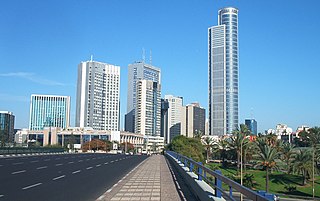
The Diamond Exchange District is a diamond district in the Israeli city of Ramat Gan. Bordering the Ayalon Highway, the road dividing Ramat Gan and Tel Aviv, the district is home to Israel's diamond industry as well as being a major commercial center.

The architecture of Israel has been influenced by the different styles of architecture brought in by those who have occupied the country over time, sometimes modified to suit the local climate and landscape. Fortified Crusader castles, Islamic madrassas, Byzantine churches, Templer houses, Arab arches and minarets, Russian Orthodox onion domes, Bauhaus-style modernist buildings, sculptural concrete Brutalist architecture, and soaring glass-sided skyscrapers all are part of the architecture of Israel.
Shlomo Aronson ; November 27, 1936 – September 12, 2018) was an Israeli landscape architect. His works range from master plans for reforestation to archaeological parks and freeway planting schemes to urban plazas.

Buky Schwartz was an Israeli sculptor and video artist.
Ram Karmi was a leading Israeli architect. He was head of the Tel Aviv-based Ram Karmi Architects company, and is known for his Brutalist style.

Arieh Sharon was an Israeli architect and winner of the Israel Prize for Architecture in 1962. Sharon was a critical contributor to the early architecture in Israel and the leader of the first master plan of the young state, reporting to then Prime Minister, David Ben-Gurion. Sharon studied at the Bauhaus in Dessau under Walter Gropius and Hannes Meyer and on his return to Israel in 1931, started building in the International Style, better known locally as the Bauhaus style of Tel Aviv. Sharon built private houses, cinemas and in 1937 his first hospital, a field in which he specialized in his later career, planning and constructing many of the country's largest medical centers.

Richard Kauffmann (1887–1958) was a German-Jewish architect who migrated to Palestine in 1920. His architecture was influenced by Ludwig Mies van der Rohe, a proponent of the International Style, and was applied to the local landscape, laying the architectural groundwork for the nascent State of Israel and the White City, as Tel Aviv's International Style architecture became known.

Nahum Zolotov was an Israeli architect and a recipient of the Rokach Prize in 1961 and in 1973. He was a recipient of the Rechter Prize.
Jacob Gil is an Israeli architect and town planner
The Keren HaKirya building complex is a proposed set of buildings in Tel Aviv, Israel. It will comprise 80-story and 50-story office towers and two 45-story residential towers that will stand above a two-story retail mall. It will be situated at the intersection of Begin Road and Sha'ul HaMelekh Street in the city's Midtown business district on an area of 38 dunams.
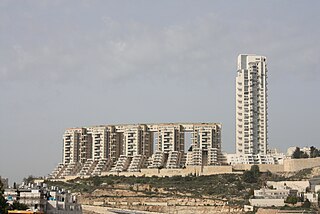
The Holyland Case, named for the Holyland Park building complex in Jerusalem, Israel, was a high-profile corruption case in which top Israeli officials were charged with bribery and money laundering, among them former Israel Prime Minister Ehud Olmert and former Mayor of Jerusalem Uri Lupolianski. Of the 13 defendants, three were acquitted and ten, including Olmert, were found guilty.
Bein Arim Tower is a planned 400 m (1,300 ft) high skyscraper to be build in the demarcated area of the Bursa on Menachem Begin Road in Tel Aviv. After its construction it will be the tallest building in Israel, followed by Tel Aviv's 238 meter high Azrieli Sarona Tower. The building is expected to be finished in 2023.
